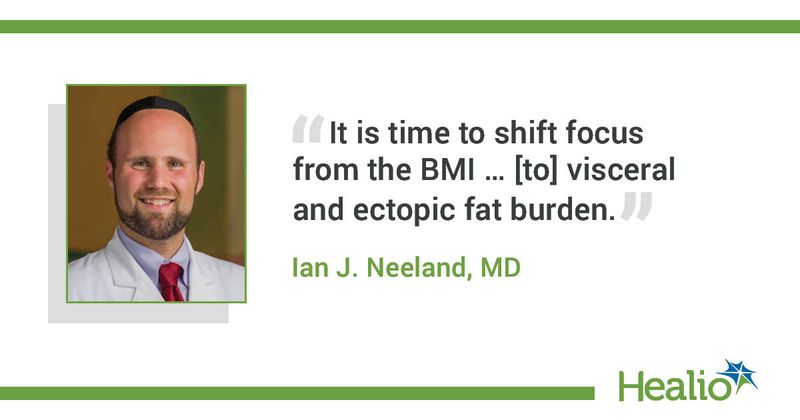Liraglutide reduces visceral, ectopic fat in obesity with high CV risk
Click Here to Manage Email Alerts
Adults with obesity at high cardiovascular risk saw significant reductions in visceral and ectopic fat after adding daily liraglutide 3 mg to a reduced-calorie diet and lifestyle plan, findings from a randomized controlled trial show.
In a single-center study, researchers also found that the relative effects of liraglutide 3 mg (Saxenda, Novo Nordisk) on fat reduction were two times greater in the abdominal viscera and six times greater in the liver than seen on overall body weight.

“Liraglutide and its related products, semaglutide (Wegovy, Novo Nordisk) and dulaglutide (Trulicity, Eli Lilly), can be key components to a comprehensive risk reduction strategy for overweight and obesity,” Ian J. Neeland, MD, director of cardiovascular prevention and co-director of the Center for Integrated and Novel Approaches in Vascular-Metabolic Disease for University Hospitals Harrington Heart and Vascular Institute, Cleveland, told Healio. “Furthermore, it is time to shift focus from the BMI as the arbiter of how well a person is managing their weight and focus more on the visceral and ectopic fat burden, which is the most important driver of disease.”
Decades of research has shown that where excess body fat accumulates makes a difference in health outcomes and the development of diseases such as CVD and diabetes, Neeland said, and visceral fat and ectopic fat are important risk factors for disease.
Change in visceral adipose tissue
In a single-center trial, Neeland and colleagues analyzed data from 185 adults recruited from the University of Texas Southwestern Medical Center with a BMI of at least 30 kg/m² or BMI of at least 27 kg/m² with metabolic syndrome but without diabetes (92% women; 37% Black; 24% Hispanic; mean age, 50 years; mean baseline BMI, 37.7 kg/m²).
From July 2017 to February 2020, researchers randomly assigned participants once-daily subcutaneous liraglutide 3 mg (n = 92) or placebo (n = 93) for 40 weeks, in addition to a 500 kcal-deficient diet and guideline-recommended physical activity counseling. The primary endpoint was percentage reduction in visceral adipose tissue (VAT) measured with MRI. All randomly assigned participants with a follow-up imaging assessment were included in efficacy analyses and all participants who received at least one dose of study drug were included in the safety analyses.
During 36.2 weeks, mean change in VAT was –12.49% with liraglutide compared with –1.63% with placebo, for an estimated treatment difference of –10.86 percentage points (95% CI, –6.97 to –14.75). Effects were consistent across subgroups of age, sex, race, BMI and baseline prediabetes status.
The most frequently reported adverse events were gastrointestinal-related (47% vs. 13% with liraglutide and placebo, respectively) and upper respiratory tract infections.
“We observed exactly what we expected to see,” Neeland, also an associate professor of medicine at Case Western Reserve University School of Medicine, told Healio. “It was surprising, though, that we saw such robust benefits despite the COVID-19 pandemic. Participants continued to adhere to the medication, which is a testament to them and shows the importance of good trial conduct, even when faced with challenges like COVID-19.”
Neeland said researchers still do not know if the mechanism of CV benefit seen with liraglutide 1.8 mg is directly related to visceral fat reduction.
“This is a key piece of information, since it would provide an opportunity to specifically target visceral and ectopic fat for risk reduction and prevention,” Neeland said.
Beyond the weight-loss endpoint
In a related editorial, Kishore Gadde, MD, the Fairfax Foster Bailey endowed chair in heart disease prevention and medical director of clinical services at Pennington Biomedical Research Center at Louisiana State University, and Steven B. Heymsfield, MD, FTOS, professor in the department of metabolism and body composition at Pennington Biomedical Research Center at Louisiana State University, wrote: “Endpoints such as changes in VAT and liver fat have far more clinical relevance and pathophysiological implications than changes in body weight or BMI, typical primary endpoints in randomized controlled trials of anti-obesity drugs.
“Advances in imaging methods now make it feasible to move beyond these classical primary endpoints towards inclusion of adipose tissue compartments and ectopic lipids as key outcome variables in future trials of new weight-loss medicines,” Gadde and Heymsfield wrote.
Reference:
Gadde KM, et al. Lancet Diabetes Endocrinol. 2021;doi:10.1016/s2213-8587(21)00204-7.

